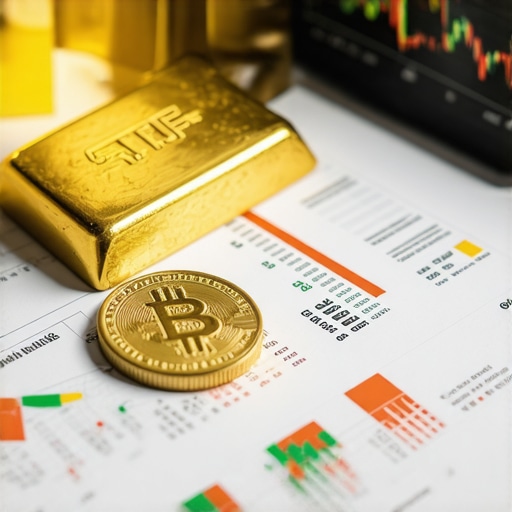Unlocking the Golden Path: Why 2025 Is a Pivotal Year for Gold Coin Investments
As global economic uncertainties and inflationary pressures persist, savvy investors are increasingly turning to gold coins as a tangible and historically resilient store of value. But how do you discern the best gold coins for investment in 2025 amid a sea of options, market fluctuations, and evolving demand trends? This guide dives deep to equip you with expert insights and practical wisdom to make informed decisions that align with your financial goals.
Decoding the Gold Coin Universe: Beyond Purity and Weight
While the intrinsic value of gold primarily hinges on purity and weight, the best gold coins for investment often carry additional layers of value. Factors such as mint reputation, market liquidity, and historical significance critically influence long-term appreciation potential. For instance, coins minted by the Royal Canadian Mint or the U.S. Mint are widely recognized and easily tradable worldwide, enhancing their investment appeal.
What Are the Top Features That Distinguish an Investment-Grade Gold Coin in 2025?
Investment-grade gold coins typically exhibit purity levels of 99.9% or higher, certified authenticity, and a stable market demand. Popular examples include the American Gold Eagle, Canadian Gold Maple Leaf, and South African Krugerrand — each offering unique advantages like legal tender status, tax benefits, or international recognition. Additionally, limited edition or commemorative coins might offer collectors’ premiums but carry greater price volatility.
Market Dynamics and Demand Trends: Aligning Your Choice with 2025 Projections
Understanding global gold demand trends is crucial. Asia’s increasing appetite for physical gold and central bank acquisitions are driving prices upward, while geopolitical tensions add layers of complexity. Choosing coins that align with these macroeconomic forces can enhance your portfolio’s resilience. For example, gold coins favored in emerging markets may see heightened demand and liquidity.
Authenticity and Security: Safeguarding Your Golden Assets
In a marketplace where counterfeit coins pose significant risks, investing in coins with verifiable certifications from trusted authorities like the Professional Coin Grading Service (PCGS) or Numismatic Guaranty Corporation (NGC) is paramount. Employing advanced authentication techniques, including laser markings and blockchain tracking, is becoming standard practice among reputable dealers, enhancing trust and security.
Expert Tip: Balancing Collectible Value with Investment Potential
While numismatic coins can offer exceptional returns, they demand specialized knowledge and carry liquidity risks. Conversely, bullion coins provide a straightforward hedge against inflation and economic uncertainty. A balanced approach often involves a core holding in bullion coins supplemented by select collectible pieces. For detailed guidance, explore our comprehensive guide on choosing gold coins for investment.
For a broader perspective on protecting your wealth with physical gold, consider reading our expert guide on how physical gold investment protects wealth in 2025.
Join the Conversation!
Have you started investing in gold coins or are considering it for 2025? Share your thoughts, experiences, or questions in the comments below and help build a community of informed investors.
Authoritative source: According to the World Gold Council, gold remains a critical asset for portfolio diversification and wealth preservation amid economic uncertainties (World Gold Council – Gold Demand Trends).
Digging Deeper: How Economic Policies Shape Gold Coin Investment in 2025
Beyond traditional factors, the influence of monetary policies and fiscal stimulus programs worldwide cannot be overstated when evaluating gold coins as investments. Central banks’ strategies, such as interest rate adjustments and quantitative easing, directly impact gold’s appeal as a safe haven asset. For instance, lower interest rates often diminish bond yields, making gold coins more attractive due to their non-yielding but intrinsic value.
Furthermore, geopolitical events and trade tensions introduce volatility that can drive investors toward physical gold, including collectible coins. Understanding these macroeconomic undercurrents enables investors to anticipate demand surges and price shifts, positioning their portfolios for optimal resilience.
The Role of Emerging Technologies in Authenticating and Trading Gold Coins
2025 marks a turning point with blockchain technology and AI-powered analytics revolutionizing the gold coin market. Blockchain provides immutable provenance records that enhance transparency and reduce fraud, while AI tools assist in market trend analysis and predictive pricing models. Such technological integration empowers investors to verify coin authenticity with unprecedented certainty and make data-driven decisions.
Leading dealers now incorporate QR codes linked to blockchain registries, creating a seamless verification process for buyers and sellers alike. This evolution not only fortifies trust but also streamlines secondary market liquidity, a crucial consideration for investment-grade coins.
How Can Investors Leverage Technology to Mitigate Risks and Maximize Returns on Gold Coins in 2025?
Investors should seek platforms and dealers that utilize advanced authentication methods, including blockchain certification and high-resolution imaging coupled with AI pattern recognition. These tools help detect counterfeits early and provide real-time market insights. Moreover, leveraging online marketplaces with transparent transaction histories can facilitate better pricing and quicker exits.
Continuous education on emerging tech trends and regulatory developments also aids investors in navigating complexities inherent in gold coin investments. Staying informed through expert resources is essential to capitalizing on the dynamic market landscape.
Market Liquidity: Why It Matters More Than Ever for Gold Coin Investors
Liquidity dictates how swiftly and efficiently an asset can be converted into cash without significant value loss. For gold coins, liquidity hinges on factors such as coin popularity, certification, and ease of resale in global markets. Coins like the Canadian Gold Maple Leaf and American Gold Eagle traditionally maintain high liquidity due to broad acceptance.
Investors should evaluate liquidity risk alongside potential appreciation to balance their portfolios effectively. Understanding market depth and bid-ask spreads can prevent inadvertent losses and ensure timely exits when market conditions shift.
Expert Insight from the World Gold Council
According to the World Gold Council, increasing central bank purchases and sustained demand in emerging markets underscore gold’s role as a strategic asset in 2025. Their research highlights that physical gold, including coins, provides unique diversification benefits that traditional financial instruments cannot replicate.
Engage with the Gold Investment Community
What are your strategies for integrating technology and market insights into your gold coin portfolio? Share your experience or questions in the comments to foster a knowledgeable investor network.
For a deeper dive into how demand trends influence gold prices and investment strategies, explore our detailed analysis on how gold demand trends impact price forecasts in 2025.
Strategic Portfolio Diversification: Integrating Gold Coins with Alternative Assets
In 2025, the sophistication of investment portfolios demands not just diversification but strategic asset allocation that harnesses gold coins as a pivotal component within a broader mix of alternative assets. Unlike traditional equities or bonds, gold coins offer intrinsic value that can act as a counterbalance during market turbulence. However, the key to unlocking superior returns lies in understanding correlation dynamics between gold and assets such as cryptocurrencies, real estate investment trusts (REITs), and commodities.
Empirical studies reveal that gold coins often exhibit a low or negative correlation with volatile assets, thereby serving as a hedge against systemic risk. Investors who calibrate their exposure—allocating 5-15% of their portfolio to physical gold coins—can enhance risk-adjusted returns while preserving liquidity. Tailoring this allocation according to macroeconomic indicators, including inflationary signals and monetary policy shifts, is essential for maximizing portfolio resilience.
What Advanced Metrics Should Investors Analyze When Optimizing Gold Coin Allocations Amidst Market Volatility?
Beyond conventional metrics like spot gold price or coin purity, sophisticated investors should incorporate advanced analytics such as the Sharpe ratio of gold holdings relative to portfolio volatility, rolling correlation coefficients, and liquidity-adjusted value-at-risk (LVaR). Tools leveraging machine learning can predict shifts in gold demand triggered by geopolitical events or fiscal policy changes, enabling proactive rebalancing. For example, integrating AI-driven sentiment analysis from global financial news streams can anticipate market reactions that influence gold coin valuations.
Moreover, evaluating the premium to spot price—considering minting, rarity, and certification—allows discerning investors to identify undervalued coins with latent appreciation potential. Such granular analysis facilitates informed decision-making that transcends simplistic buy-and-hold strategies.
Tax-Efficient Strategies: Navigating Complex Regulatory Landscapes for Gold Coin Investments
Tax implications remain a critical yet often overlooked dimension of gold coin investing. Jurisdictions vary widely in how they classify and tax physical gold, impacting net returns. For instance, in the United States, certain gold coins qualify as collectibles and are subject to higher capital gains tax rates, whereas in countries like Singapore or Switzerland, exemptions or favorable treatments may apply.
Expert investors collaborate with tax advisors to employ strategies such as utilizing self-directed IRAs, offshore trusts, or gold-backed exchange-traded funds (ETFs) to mitigate tax liabilities while retaining exposure to physical gold. Understanding nuances—such as the impact of import duties, VAT, and reporting requirements—is indispensable for compliance and optimization.
Careful documentation and certification are also integral to ensuring that gold coins retain their tax-advantaged status, especially when dealing with cross-border transactions or estate planning. Staying abreast of evolving regulations through authoritative sources like the OECD Tax Database empowers investors to adapt strategies proactively.
Leveraging Global Market Insights: Capitalizing on Regional Demand and Supply Imbalances
The gold coin market in 2025 is increasingly influenced by regional demand-supply disparities driven by cultural preferences, economic growth trajectories, and regulatory environments. For example, Asian markets continue to exhibit robust demand for gold coins due to cultural affinity and wealth accumulation, while Western markets may experience fluctuating demand tied to investment cycles.
Investors who monitor import-export data, central bank purchase patterns, and retail sales metrics gain a competitive edge. Platforms offering real-time trade flow analytics enable timely acquisitions and disposals aligned with regional price premiums. Additionally, niche markets for collectible coins—such as limited mintage issues from emerging mints—present unique arbitrage opportunities when regional demand surges.
Engaging with expert networks and subscribing to specialized market intelligence reports can uncover subtle market signals that precede broader price movements. Such proactive intelligence is invaluable for positioning portfolios ahead of cyclical trends.
Expert Corner: Harnessing AI and Blockchain for Transparent and Efficient Gold Coin Transactions
Integrating AI algorithms with blockchain technology is revolutionizing gold coin trading by enhancing transparency, reducing fraud, and streamlining liquidity. Smart contracts automate verification and settlement processes, minimizing counterparty risk. Moreover, fractional ownership models enabled by tokenization democratize access to high-value gold coins, expanding the investor base and improving market depth.
Investors should explore platforms that combine these technologies with rigorous third-party certification, ensuring provenance and authenticity. Continuous innovation in this domain is likely to redefine how gold coin investments are managed and traded, underscoring the importance of staying informed through cutting-edge expert content.
Ready to elevate your gold coin investment strategy? Explore our comprehensive expert resources and join a community committed to mastering the complexities of gold investing in 2025 and beyond.
Unveiling the Impact of Geopolitical Shifts on Gold Coin Valuations
The intricate interplay between geopolitical tensions and gold coin valuations in 2025 demands a nuanced understanding from seasoned investors. Political unrest, trade disputes, and shifts in diplomatic relations often catalyze rapid fluctuations in gold demand, especially for coins with recognized international provenance. Investors attuned to these geopolitical undercurrents can anticipate market surges and identify opportune entry or exit points, leveraging gold coins not merely as static assets but as dynamic hedges against systemic risk.
How Do Geopolitical Events Specifically Influence the Premiums and Liquidity of Gold Coins?
Geopolitical crises typically trigger increased safe-haven buying, elevating premiums on widely accepted gold coins such as the Krugerrand and the Gold Maple Leaf. Concurrently, liquidity may tighten as market participants hoard physical assets, leading to wider bid-ask spreads. However, coins with robust certification and international recognition tend to retain superior liquidity, providing investors with strategic flexibility. Monitoring real-time geopolitical developments alongside regional demand indicators enables proactive portfolio adjustments.
Decentralized Finance Meets Physical Gold: The Emergence of Tokenized Gold Coins
Tokenization of gold coins, facilitated through blockchain technology, is reshaping access and ownership models within the precious metals market. By representing physical gold coins as digital tokens, investors can partake in fractional ownership, enhance portfolio diversification, and benefit from increased liquidity without relinquishing underlying physical assets. This paradigm shift democratizes gold investment, attracting a broader investor base while maintaining rigorous provenance and authenticity standards.
Integrating Tokenized Assets Within Traditional Gold Coin Portfolios
Strategically combining tokenized gold coins with physical holdings allows investors to harness the liquidity and accessibility of digital assets alongside the tangible security of minted coins. This hybrid approach mitigates risks associated with storage and transport while capitalizing on blockchain-enabled transparency and traceability. As regulatory frameworks evolve, early adopters of tokenized gold coins may gain competitive advantages in portfolio agility and cost efficiency.
Advanced Risk Mitigation: Navigating Regulatory and Market Volatility
In an increasingly complex regulatory environment, gold coin investors must adopt proactive compliance strategies. Understanding jurisdiction-specific regulations governing gold ownership, reporting, and taxation is critical to avoid unforeseen liabilities. Additionally, deploying advanced analytics to monitor market signals, including central bank policies and macroeconomic indicators, empowers investors to recalibrate holdings in response to volatility, optimizing risk-adjusted returns.
Authoritative insights from the Investopedia Gold Coin Investment Guide emphasize the importance of blending traditional valuation metrics with emerging technological tools to navigate 2025’s multifaceted gold market effectively.
Take Your Gold Investment Strategy to the Next Level
Harness these advanced perspectives and technological innovations to refine your gold coin portfolio with precision and foresight. Engage with our expert community to exchange insights, stay abreast of evolving trends, and optimize your investment outcomes in a rapidly transforming marketplace. Explore our premium resources and elevate your approach today.
Frequently Asked Questions (FAQ)
What factors determine the long-term value of gold coins beyond their gold content?
Beyond purity and weight, elements such as mint reputation, coin certification, historical significance, and market liquidity substantially impact a gold coin’s long-term value. Coins from established mints like the Royal Canadian Mint or U.S. Mint often command premiums due to global recognition and ease of resale. Additionally, limited editions or numismatic coins may carry collector premiums, though with potentially higher price volatility.
How does blockchain technology improve the security and authenticity of gold coin investments?
Blockchain provides an immutable, transparent ledger that records provenance and transaction history of gold coins. This technology reduces fraud risk by enabling buyers and sellers to verify authenticity easily via QR codes linked to blockchain registries. Coupled with AI-powered analytics, investors gain enhanced assurance and real-time market insights, fostering trust and streamlining secondary market liquidity.
What are the tax considerations investors should be aware of when purchasing gold coins internationally?
Tax treatment of gold coins varies widely by jurisdiction. Some countries classify certain gold coins as collectibles, attracting higher capital gains taxes, while others offer exemptions or favorable rules. Import duties, VAT, and reporting requirements also differ. Collaborating with tax professionals and staying informed on regulations, such as those cataloged by the OECD Tax Database, is crucial for compliance and optimizing net returns.
Can tokenized gold coins replace physical gold coins in an investment portfolio?
Tokenized gold coins offer fractional ownership and enhanced liquidity by representing physical coins on blockchain platforms. While they provide accessibility and transparency advantages, they do not replace the tangible security of physical gold coins. A hybrid portfolio combining both tokenized and physical gold assets can maximize flexibility, security, and market efficiency.
How do geopolitical events influence gold coin premiums and liquidity?
Geopolitical tensions typically increase safe-haven demand, elevating premiums on widely accepted gold coins such as the Krugerrand and Gold Maple Leaf. This heightened demand can tighten liquidity, leading to wider bid-ask spreads. However, coins with robust certification and international acceptance generally maintain better liquidity, allowing investors to navigate volatile markets strategically.
What advanced metrics help optimize gold coin portfolio allocations amidst market volatility?
Investors should analyze metrics like the Sharpe ratio relative to portfolio volatility, rolling correlation coefficients with other assets, and liquidity-adjusted value-at-risk (LVaR). Incorporating AI-driven sentiment analysis and predictive modeling can anticipate demand shifts triggered by geopolitical or economic events, enabling timely portfolio rebalancing for risk-adjusted returns.
Why is market liquidity critical when selecting gold coins for investment?
Liquidity determines how quickly and efficiently gold coins can be converted to cash without significant price impact. Popular coins with broad recognition and certification, such as the American Gold Eagle and Canadian Gold Maple Leaf, typically offer higher liquidity. Considering liquidity ensures investors can exit positions promptly, especially during market stress.
How can investors leverage emerging technologies to mitigate risks in gold coin investing?
Utilizing platforms that integrate blockchain certification, AI-powered authentication, and high-resolution imaging mitigates counterfeit risks. Additionally, accessing online marketplaces with transparent transaction histories enhances pricing accuracy and liquidity. Continuous education on technological advancements and regulatory changes further empowers investors to manage risks effectively.
What role do central bank policies play in shaping gold coin investment dynamics?
Monetary policies, including interest rate adjustments and quantitative easing, influence gold’s attractiveness as a non-yielding safe haven. Lower interest rates typically reduce bond yields, enhancing gold coin appeal. Central bank gold purchases can drive demand and price volatility, making policy monitoring essential for strategic investment timing.
How should investors integrate gold coins within a diversified portfolio?
Allocating 5-15% of a portfolio to physical gold coins can provide a hedge against inflation and systemic risks due to gold’s low or negative correlation with equities and other assets. Strategic allocation should account for macroeconomic indicators and liquidity needs, balancing bullion coins for stability and select numismatic pieces for potential appreciation.
Trusted External Sources
- World Gold Council – A leading authority providing comprehensive research on gold demand trends, investment dynamics, and market analysis, invaluable for understanding macroeconomic influences on gold coin investments.
- Professional Coin Grading Service (PCGS) – Offers trusted certification and grading standards critical for verifying authenticity and condition, thereby influencing liquidity and premiums in the gold coin market.
- Numismatic Guaranty Corporation (NGC) – Renowned for third-party grading and certification services that enhance transparency and investor confidence in collectible gold coins.
- OECD Tax Database – Provides detailed and up-to-date information on tax regulations across jurisdictions, essential for navigating the complex tax landscape of international gold coin investing.
- Investopedia Gold Coin Investment Guide – Delivers expert insights blending traditional valuation metrics with emerging technologies and risk management strategies relevant to 2025 market conditions.
Conclusion
Investing in gold coins in 2025 requires a nuanced approach that balances traditional fundamentals like purity, mint reputation, and liquidity with cutting-edge technologies such as blockchain and AI analytics. Understanding evolving geopolitical landscapes, tax implications, and market demand trends further empowers investors to optimize portfolio resilience and returns. Whether through physical bullion, collectible coins, or innovative tokenized assets, gold coins remain a pivotal asset class for diversification and wealth preservation amidst global economic uncertainties. Engage with expert resources, leverage advanced metrics, and participate in informed communities to elevate your gold coin investment strategy for sustained success. Share your insights, explore related expert content, and apply these comprehensive strategies to confidently navigate the dynamic gold market landscape in 2025 and beyond.











The post really highlights how 2025 could be a transformative year for gold coin investments, especially with the integration of blockchain and AI to authenticate and track coins. I particularly resonate with the emphasis on mint reputation and liquidity because when I started investing, I found that coins like the Canadian Gold Maple Leaf had a much smoother resale process, especially internationally. Another aspect that stood out is balancing bullion coins with numismatic pieces — I’ve personally stuck mostly with bullion for stability but occasionally venture into collectible coins to add some growth potential, though I’m cautious of their volatility. With geopolitical tensions influencing premiums and liquidity, I wonder how others approach timing their entries and exits? Do you rely on geopolitical news cues, or do you prefer a more long-term hold regardless of short-term fluctuations? It would be great to hear how fellow investors navigate market volatility while leveraging these emerging technologies to protect their portfolios.
Marissa, I found your question about timing entries and exits in gold coin investments particularly compelling. Personally, I lean towards a hybrid approach: maintaining core holdings for the long term to benefit from gold’s historical role as a safe haven, while also staying alert to geopolitical developments that might create short-term opportunities. The integration of blockchain and AI tools mentioned in the post has been a game-changer for me, especially for quickly verifying authenticity and accessing real-time market data, which aids in making more informed timing decisions. I’ve noticed that during geopolitical tensions, while premiums may spike, liquidity often tightens, so I tend to approach such periods with caution, prioritizing coins with strong mint reputations and certification to mitigate risks. Has anyone experimented with AI-driven sentiment analysis platforms for predicting market shifts? I’m curious how effective these tools have been in practice for managing volatility and enhancing portfolio responsiveness.
I really appreciate the detailed dive into how 2025 is shaping up as a critical year for gold coin investing, especially the emphasis on integrating both traditional factors and new technologies. One aspect that struck me was the role of blockchain and AI in authentication — having personally witnessed the challenges posed by counterfeit coins early in my investing journey, I find that buying coins with verifiable certifications from PCGS or NGC, complemented by blockchain provenance, adds a level of confidence that’s hard to beat.
Regarding the existing discussion on timing market entries and exits amid geopolitical tensions and volatility, I tend to view gold coins as a longer-term hedge against systemic risk, rather than attempting to time the market based on news events. The premium spikes and liquidity squeezes during crises can be tricky to navigate, so I prioritize high-liquidity coins from respected mints which can be sold more easily, even in turbulent times. On the AI-driven sentiment analysis mentioned, I haven’t fully experimented with those platforms yet but am intrigued by their potential to anticipate demand shifts and improve portfolio adjustments.
For those using advanced tech or combining bullion and numismatic coins, how do you balance the trade-off between liquidity and potential appreciation? Does reliance on emerging technologies meaningfully change your approach to these decisions? I’d love to hear more from the community on how tech is redefining practical gold coin investing strategies in today’s market.